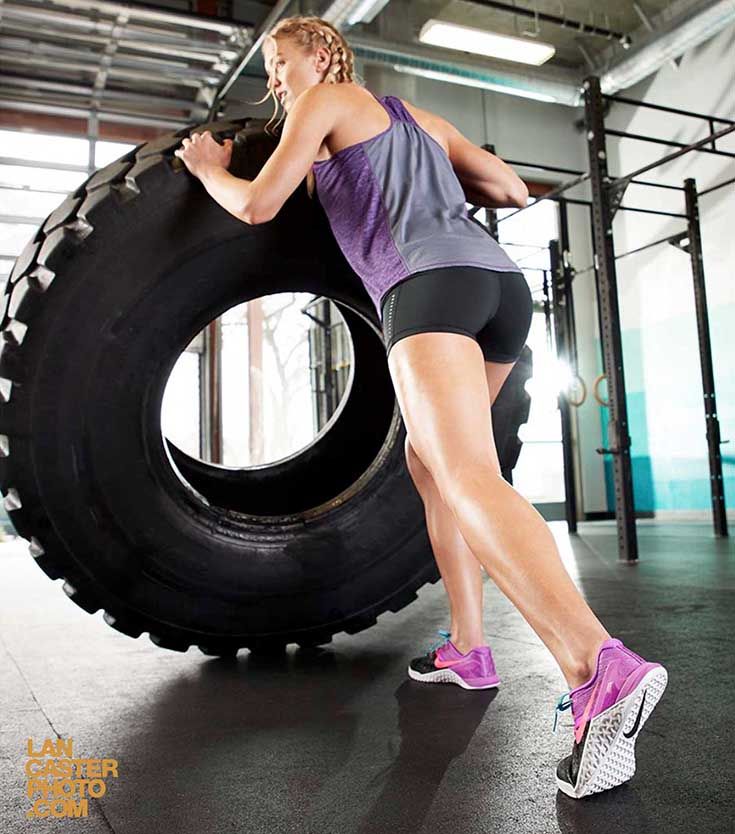Summer might be winding down, but that doesn't mean you have to kiss outdoor workouts goodbye. There's no better way to push yourself while enjoying the fresh air than with a tire workout. This one, basic piece of equipment offers up a ton of workout variations. Plus, tires can be acquired rather easily and are great for challenging your power, strength, and conditioning.
I have an NCAA D1 background in volleyball and track, and I like to keep sports performance and functional training in my regimen. While I currently train for a balanced and well-conditioned physique to compete as an IFBB bikini pro, that doesn't mean I need to let my athleticism suffer. Tire workouts are the perfect way to get physique and performance benefits in one stop.
I purchased my giant tire from a local shop. Not sure where to get yours? Do some research online to scope out a tire dealership or a place that sells farm tires. In most cases, they'll be pretty cheap (between $20-100). Otherwise, drive around with your eyes peeled for a free junkyard tire.
The next step is to consider the weight you want to use. For women, I suggest anywhere from 100-300 pounds, which will vary depending on your strength and goals. (I weigh 105 pounds, and my tire is roughly 200 pounds.) For men, 300-500 pounds is great to kick your workout into high gear.
Keep in mind that, if you want to rep it out, you can still have an effective workout with a relatively light tire. Safety is top priority, so stick with a size that's realistic for you.
Once you've got your weapon of choice, you can throw any or all of the following exercises together in a full circuit-style workout, or you can do them individually. Again, consider what's most realistic for you and how you like to train. The weight of your tire will help you determine the reps and sets in your program.
Below are some of my favorite exercises and their benefits.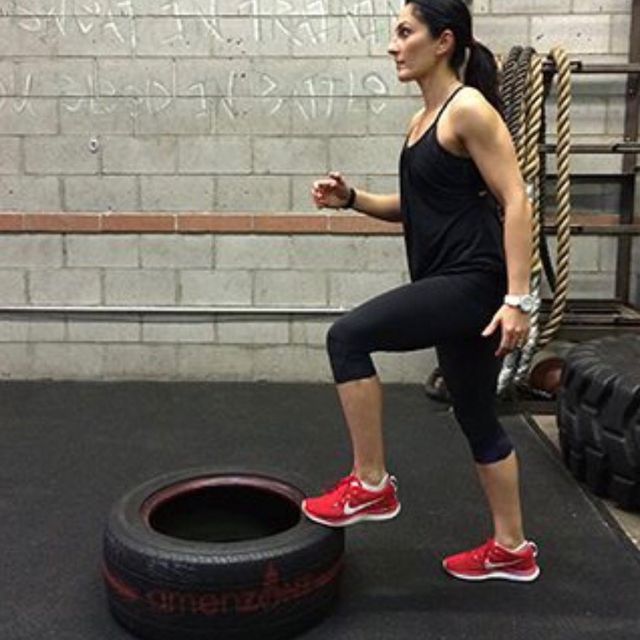 Check them out!
Check them out!
Lay your tire flat on its side like a box. Face the tire with your feet shoulder-width apart. Squat down slightly, as if you're going to jump straight into the air. Your arms will naturally swing backwards and return forward as you leap onto the tire. Both feet should land softly on the tire. While the tire has some give to it, landing too heavily can hurt your knees upon impact. Consider this practice.
Benefit: Tire jumps are a functional exercise that can help improve your explosiveness for running and increase your vertical jump. As your vertical jump improves, test yourself by gradually increasing the height of the object you're using.
Facing away from the tire, place your arms behind you. Rest the palms of your hands on the tire with your arms fully extended. Place your feet approximately half of your body length in front of the tire. This will be your starting position. Bend at the elbows into a 90-degree angle while lowering your body slowly until your bottom almost touches the ground.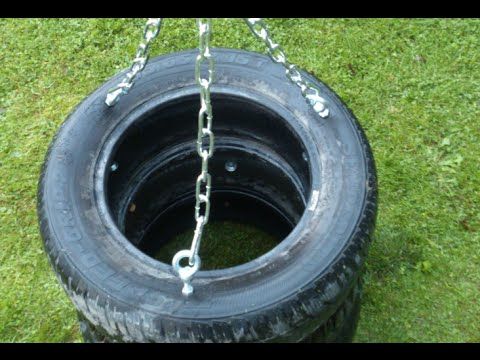 Return to a straight-arm position. This is one full repetition.
Return to a straight-arm position. This is one full repetition.
Benefit: This exercise is the same as a bench dip—it's a slow, controlled movement to work your triceps. If the movement is too easy, add a plate to your lap or use it as an "active rest" in between other tire-based exercises.
This exercise really takes floor push-ups from beginner to advanced. Facing away from the tire, place your hands on the floor slightly wider than shoulder-width apart. Place both of your feet on the tire behind you and raise yourself up into a plank position. Keeping your body straight, lower your upper body toward the floor by bending both arms at 90-degree angles. Next, push up until your arms are fully extended again.
Benefit: This will primarily work the upper pectoral muscles, in addition to the lower pecs and core.
Begin by standing upright and parallel to the tire. Next, squat slightly, bending your knees in a way that distributes your weight evenly.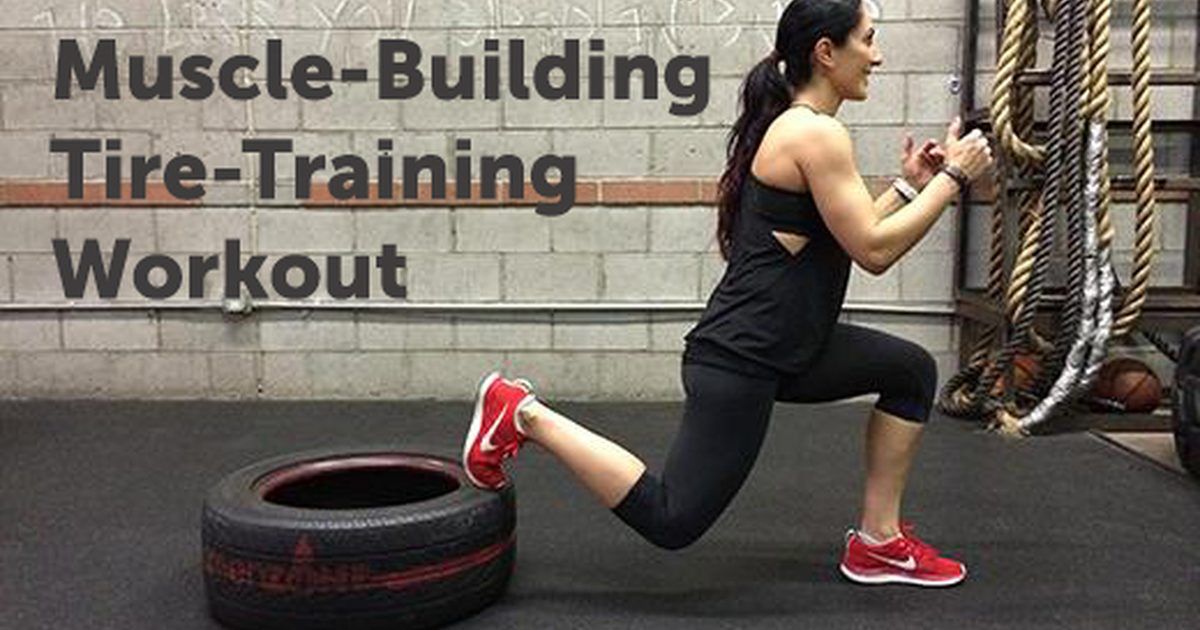 Avoid curving your back or bending at the hips. Jump sideways (laterally) onto the tire, and land in a half-squat position. As with a box jump, you want to land softly to lessen impact. Step (or jump) down from the tire and repeat.
Avoid curving your back or bending at the hips. Jump sideways (laterally) onto the tire, and land in a half-squat position. As with a box jump, you want to land softly to lessen impact. Step (or jump) down from the tire and repeat.
Benefit: Lateral movements—jumps, in this case—are a great way to develop power and agility through explosiveness while improving strength in your lower body (hip abductors, adductors) and stability in your ankles, hips, and knees. Performing a lateral jump includes squatting, a great lower-body and core exercise.
Stand facing the tire. Drive your left knee up and touch the tire with your toe. As your left knee drives up, your right arm will swing back, similar to a running stance. Return your left foot to the ground as you drive your right knee up, your left hand back, and your foot to the tire. Repeat. The key is to move as quickly and swiftly as possible. The lighter you tap the tire, the quicker you can switch feet.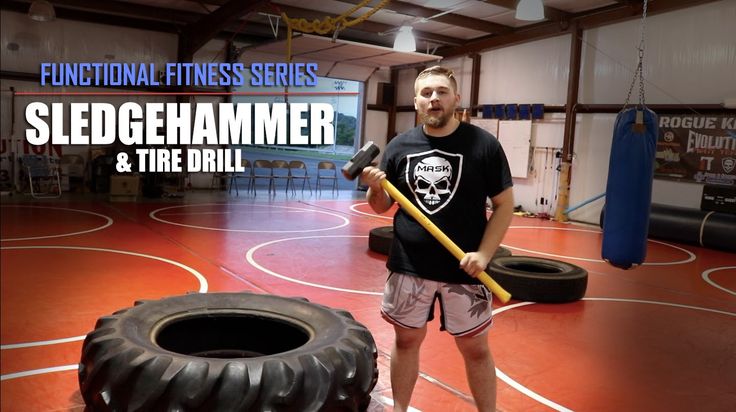
Benefit: This exercise focuses on acceleration and foot speed and develops your hip flexors. Weak hip flexors can affect your stride length and overall speed.
Face the tire and place your left foot on it. Use this platform as a foundation to push off the step. Push through your heel to explode vertically. While in the air, your legs will naturally meet again side by side; switch your opposite leg to rest on the tire as you come down. Land softly on the ball of your stable foot so you can promptly explode back up to repeat.
Benefit: This exercise trains the legs and hips with the quads and glutes. The intent is to explode from the tire in a speedy manner, and this explosiveness can be transferred into many sports activities.
Stand straight with your feet shoulder-width apart. Drop into a squat as you swing your arms back. As you explode into your maximum jump, swing your arms through, using that momentum to thrust your hips forward and land as far forward as possible.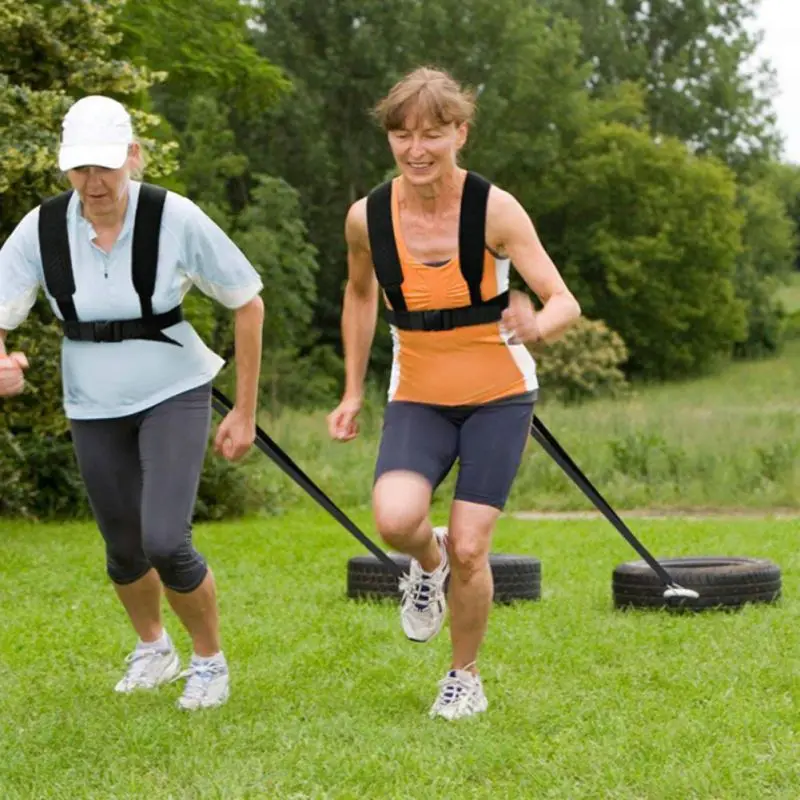 You should land in a controlled squat position with both feet. A strong core can help you land properly.
You should land in a controlled squat position with both feet. A strong core can help you land properly.
More advanced broad jumpers can perform this one leg at a time. The key to a broad jump is to jump as far forward as possible from a static position, and to land balanced. The momentum should not be generated with a prestep or hop before the jump.
Benefit: This is a great exercise to develop explosive power and improve the fast-twice muscle fiber reaction; it requires your leg and core muscles to quickly contract to create maximum force with each jump.
Lay the tire flat on the ground. Stand in the hole in the center of your tire. Bend your knees slightly and hop upward to land on the tire in a 90-degree squat with both feet on opposite sides of the tire. Hop upward again, returning to a standing position within the hole of the tire. This is one repetition. Repeat.
Benefit: Pop squats target your glutes, quads, hamstrings, and core.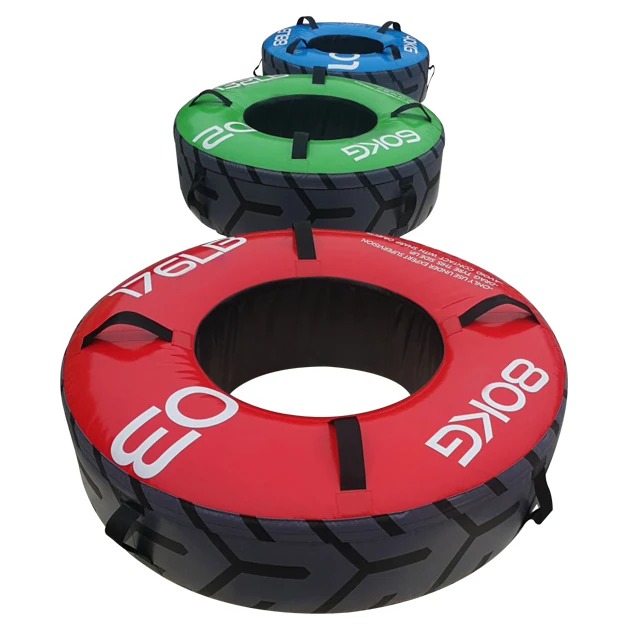 Do enough of these at a relatively fast pace and you'll also improve cardiovascular endurance.
Do enough of these at a relatively fast pace and you'll also improve cardiovascular endurance.
Start with the tire flat on the ground. Place your fingers under the tire while it is in this position. Your hands and feet should be shoulder-width apart. Squat down deep, bending at the knees. As you return to a standing position, pull the tire up. Make sure to use your whole body—especially your legs—to avoid lifting solely with your back. The momentum you create should allow you to change your hand position from a pull to a push. Push the tire forward. Once it is flat, repeat the process.
Benefit: Tire flips cover all the bases—your core, back, legs, arms, and shoulders. Just be careful when you bend to pick the tire up. Leave your ego at home! If you need a lighter tire, make the switch. You can risk serious injury if you are bending at the hips and using your back instead of bending at the knees and using your full body and engaged core to lift and push.
"Tire flips cover all the bases—your core, back, legs, arms, and shoulders."
If you're very comfortable with the above exercises, then I encourage you to try some more advanced tire workouts. How do you know if you are ready? Use the following as a gauge:
This is a three-step process (two jumps and a flip). First, you jump into the hole of the tire. Second, you jump forward (out) of the tire, landing on the opposite side you came from. Lastly, you turn to face the tire and prepare to flip it in the direction you came from. Repeat for 8-10 flips, or as many as you can before you need to rest.
Benefit: This is a power and strength exercise from head to toe. As an added benefit, it also tests your cardiovascular system!
The tire should be standing upright. You and a partner will each face one side of the tire and stand about arm's-length apart. Prepare your foundation with a staggered stance; plant one foot slightly ahead of the other at a distance that feels good for you. Place your hands (palms facing forward) in line with your chest, and push the tire back and forth. Your elbows should be slightly bent, so you can receive the tire with a cushion, and then push the tire back to your partner.
Benefit: Similar to the bench press, this movement engages your chest as you push, and your arms as you receive the tire from your partner. You also need strong legs and core to withstand the weight of the tire. This is a fun way to work on your upper-body strength.
Have a friend time you as you complete tire flips for 20-25 yards.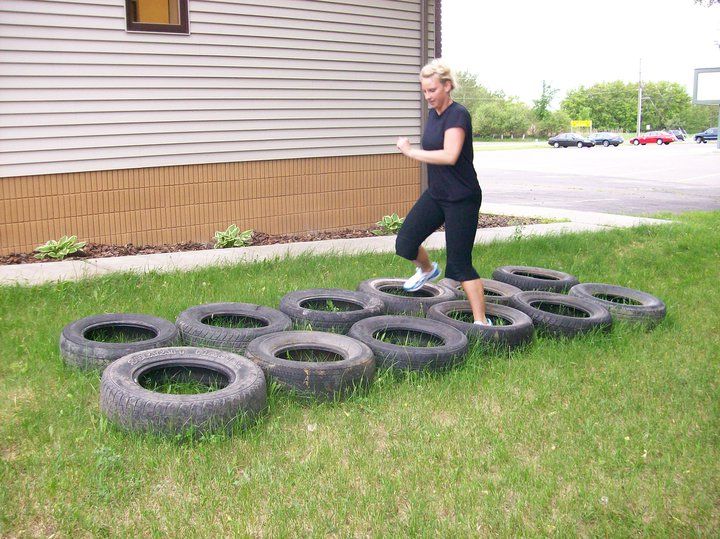 Once you finish flipping— from start to finish—turn around and sprint back to the start. Take a 1-2 minute rest as your friend completes the same exercise. Complete two more rounds, and try to beat your time each round.
Once you finish flipping— from start to finish—turn around and sprint back to the start. Take a 1-2 minute rest as your friend completes the same exercise. Complete two more rounds, and try to beat your time each round.
Benefit: This strengthening exercise also incorporates explosive power from sprints.
Lateral jump from one side of the tire, onto the tire, and then onto the other side. Complete a burpee. Jump laterally back onto the tire, then jump onto the other side. Do a burpee. Repeat. One burpee on each side of the tire is 1 full repetition. Complete 10 reps in each set.
Benefit: Burpees and jumps alone can get old fast. This is an unconventional way to take regular exercises to another level. Is the tire necessary? Not really, but it's a fun one to try with a partner, or alone to really get your heart pumping.
Now, let's put it all together! Here's a glimpse of how I would combine the exercises we just discussed. Warm up with a 10-minute run/walk followed by dynamic stretching. This is crucial; don't forget to stretch!
Warm up with a 10-minute run/walk followed by dynamic stretching. This is crucial; don't forget to stretch!
I have the circuit broken down into three groups of three exercises. All nine exercises equal one round. You may take a rest after every third exercise, if needed. If not, power through until you complete one full round. Then, take 1-2 minutes rest.
Looking for that little extra push? One you've finished three rounds, try this gasser. Complete a 20-25 yard continuous tire flip to one end of the street; then sprint back to the start. Have your partner time you. Rest for 1 minute and repeat 3-5 times, trying to set a PR each time.
Complete a 20-25 yard continuous tire flip to one end of the street; then sprint back to the start. Have your partner time you. Rest for 1 minute and repeat 3-5 times, trying to set a PR each time.
Gone are the days when training was limited to the same old traditional gym equipment.
While originally used in strongman and strongwomen competitions, tires have become a staple in well–equipped gyms throughout the world.
They allow for a unique kind of strength and conditioning training that readily transfers to a variety of sports.
This article lays out the best tire exercises, the muscles they work, and a sample tire circuit to get you started.
The key to performing tire exercises is selecting a tire of the right size and weight to meet your level of strength and experience, as well as to avoid injury.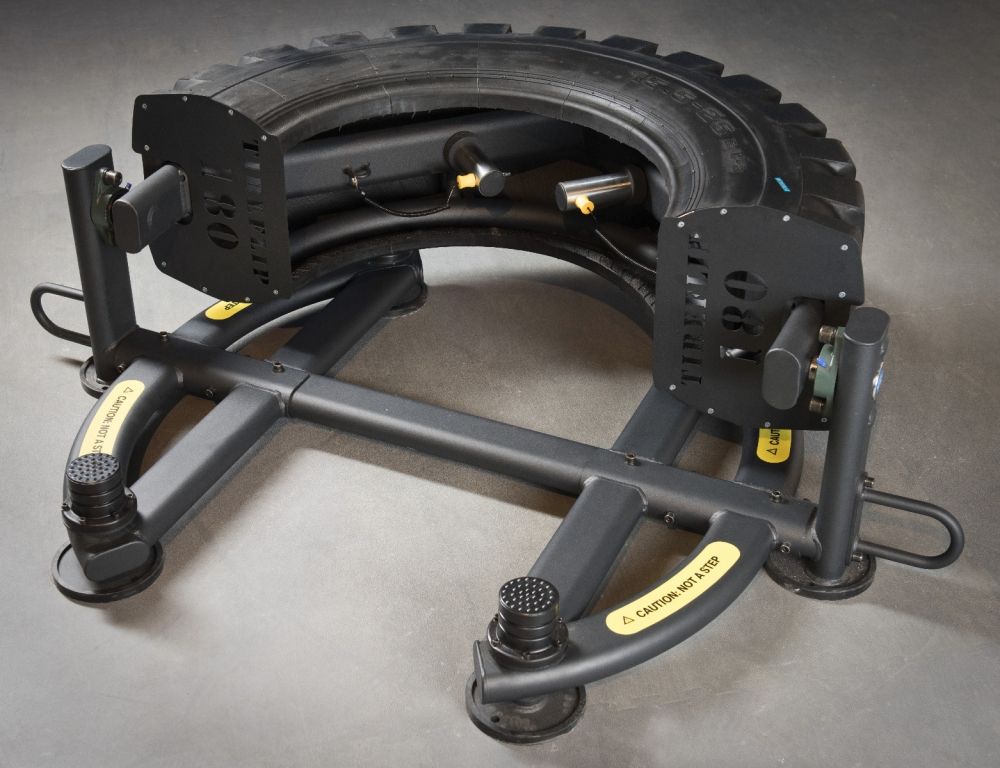
Start with a smaller, lighter tire and work your way up to a larger, heavier tire as you progress in strength and skill. It’s recommended that women begin with a tire that weighs 100–200 pounds (45–90 kg), while men are recommended to start with a 200–300-pound (90–135-kg) tire.
As a rule of thumb, you should be able to do 2–5 repetitions of the exercises below with consistency. If you can’t, the tire is probably too heavy.
Estimating the weight of a tire is not an exact science. Still, there are some averages, according to size (1, 2).
| Tire size | Average tire weight |
| Car tire | 25 pounds (11 kg) |
| Commercial truck tire | 100–200 pounds (about 45–91 kg) |
| 17.5 x 25 foot tractor tire | 300 pounds (136 kg), maximum |
| 20.5 x 25 foot tractor tire | 400–500 pounds (181–227 kg) |
23.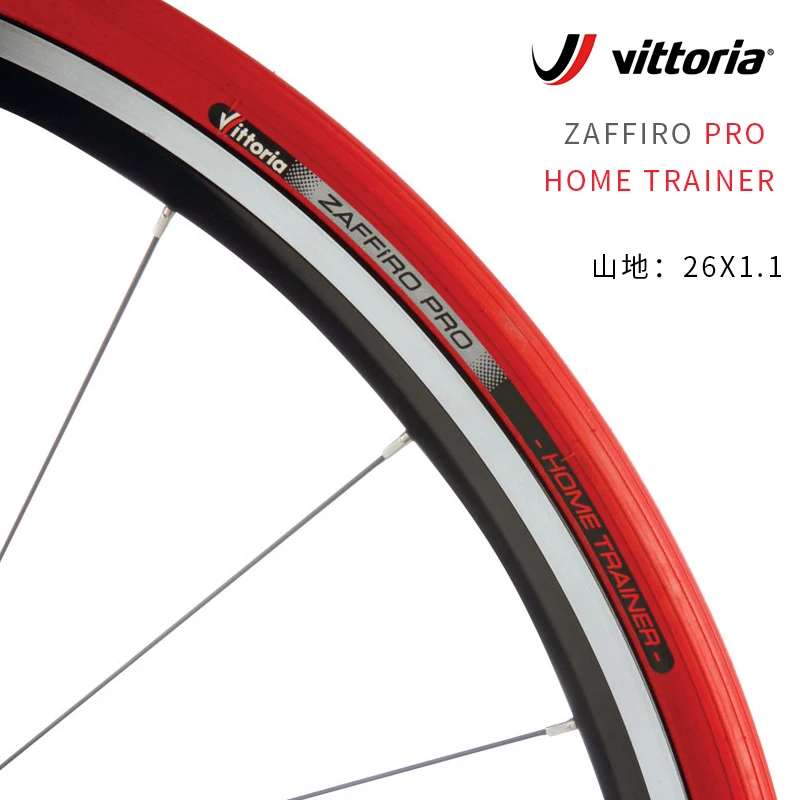 5 x 25 foot tractor tire 5 x 25 foot tractor tire | 400–800 pounds (181– 363 kg) |
| 26.5 x 25 foot tractor tire | 1,000 pounds (454 kg) |
It can be tricky to know how much a tire weighs because it’s difficult to put a large tractor tile on a scale. If you’re hauling it by truck, you can drive to a CAT scale, measure the weight of your truck with the tire, and then subtract the weight of your truck to find the weight of the tire.
Some specialized tires allow weights to be added or removed, making the process of adding resistance a bit easier.
SummaryTires can be hard to weigh, and their weights are often estimated. Select a tire size that allows you to complete at least 2–5 reps consistently.
Tire availability varies depending upon where you live.
Those in rural areas may find it easier to find old tires from agricultural equipment, which also tends to be the most cost-effective source.
You may want to check local online classified ads for listings of people selling used tires, as larger new tires tend to be quite expensive.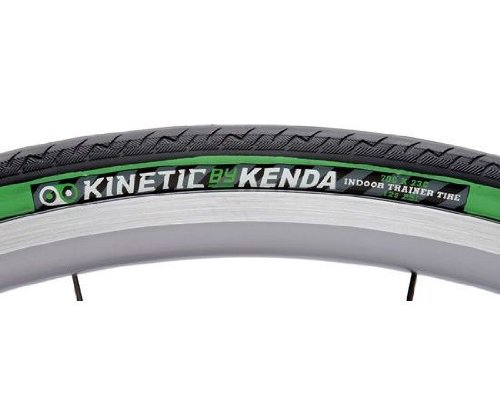
While car tires can work for some exercises, you’ll want a slightly larger tire to best perform most movements, especially as your strength and skill increase.
Fortunately, many gyms now have an outdoor or indoor turf area with access to tires.
SummaryThe tire flipTires are best found by searching local online classified ads or contacting a farm that has agricultural equipment. Also, many gyms now have a turf area with tires of various sizes for members to use.
The tire flip is a classic tire exercise that enhances explosive power development from head to toe.
The key to this exercise is selecting the right tire size and weight to meet your level of strength and experience, as well as to avoid injury.
Muscles worked: glutes, hamstrings, quads, calves, lats, traps, biceps, triceps, forearms, abs (to stabilize)

The tire deadlift with farmer’s walk is a unique tire exercise that provides all of the benefits of a traditional deadlift movement with an added conditioning aspect.
This movement requires excellent core and grip strength to stabilize the tire during the farmer’s walk portion of the exercise.
Muscles worked: glutes, hamstrings, quads, lats, traps, biceps, forearms, abs

This movement can also be performed without the farmer’s walk portion as a deadlift only for a designated amount of sets and reps.
Tire slamsThe tire slam is an excellent movement for developing upper-body power and endurance through various planes of motion.
This exercise requires a sledgehammer or mace as a training device with which to strike the tire.
You’ll want to use a tire that’s large enough to absorb the shock of the impact without moving around too much.

The tire slam can be performed in timed intervals, during which you strike the tire for a designated amount of time, or in sets, during which you perform a given number of reps or strikes.
Tire broad jump with tire flipThis is a dynamic exercise that combines two popular tire exercises to maximize your training adaptations.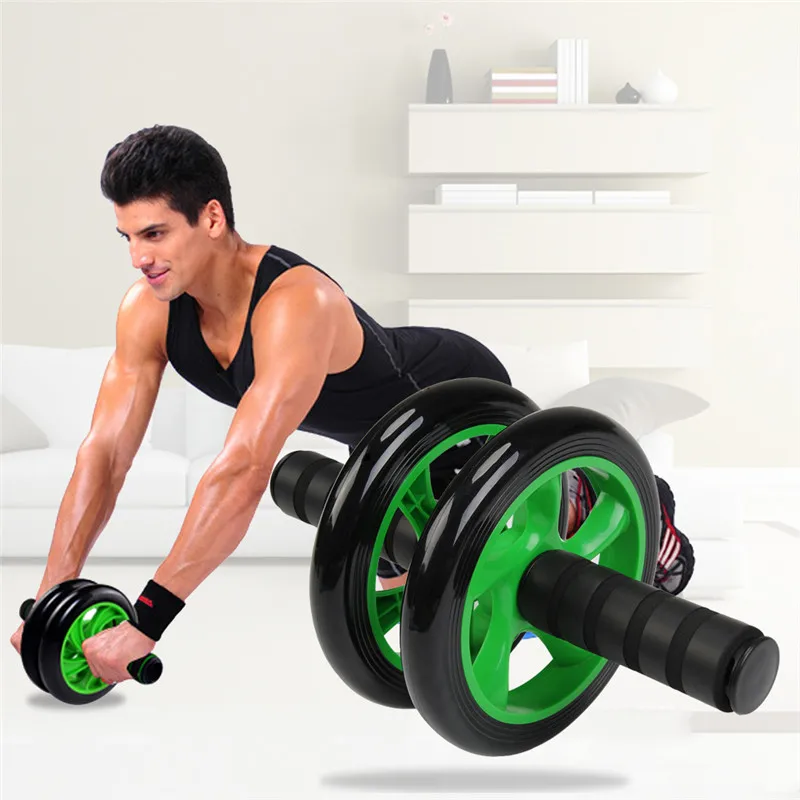
For this exercise, it’s best to select a lighter tire that you can comfortably jump over repeatedly.
Muscles worked: quads, hamstrings, glutes, calves, lats, traps, biceps, forearms, abs
Box jumps are a common plyometric exercise in which your muscles exert maximal force for a brief period of time.
In this variation, a tire is used instead of a box, providing an added layer of difficulty, as you’ll need to stabilize yourself on the landing due to the flex of the tire.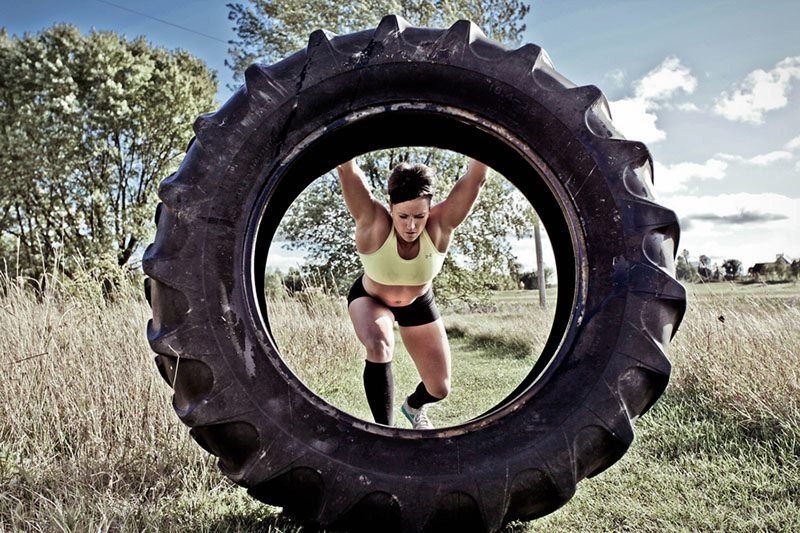
Select a tire of an appropriate height for your skill level.
Two tires can be stacked on top of one another as you become more advanced.
Muscles worked: quads, hamstrings, glutes, calves, abs
Tire pushups are a versatile upper-body exercise that can be adjusted for your desired level of difficulty.
Beginners should perform torso-elevated pushups, which will decrease the resistance, whereas more advanced trainees may want to try leg–elevated pushups to crank up the resistance.
Muscles worked: pecs (chest muscles), anterior delts, triceps, abs
Torso-elevated pushups (easier)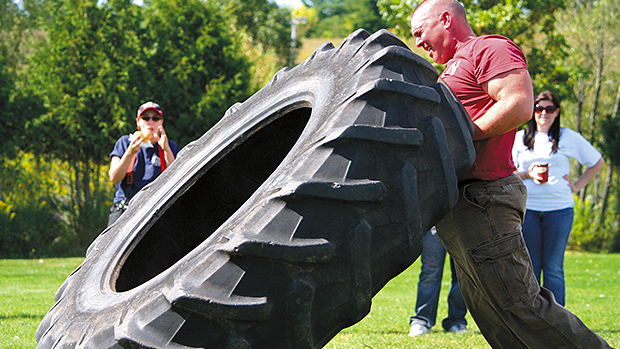
Planks are a challenging exercise that targets your abdominal muscles.
In this variation, you’ll use a tire to increase or decrease the difficulty level.
To make the exercise slightly easier, you’ll perform an incline plank, or if you want to kick things up a notch, you can perform a decline plank.
Muscles worked: abs, obliques (side abs), lower back
Incline plank (easier)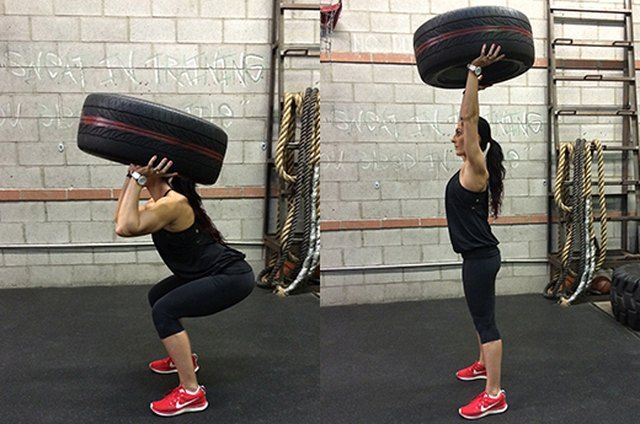
Tire dips are a fantastic exercise for isolating the triceps, as well as a great addition to any well–rounded tire circuit.
For this movement, you’ll want to use a tire large enough to support your body weight without tipping over.
Muscles worked: triceps, pecs, shoulders
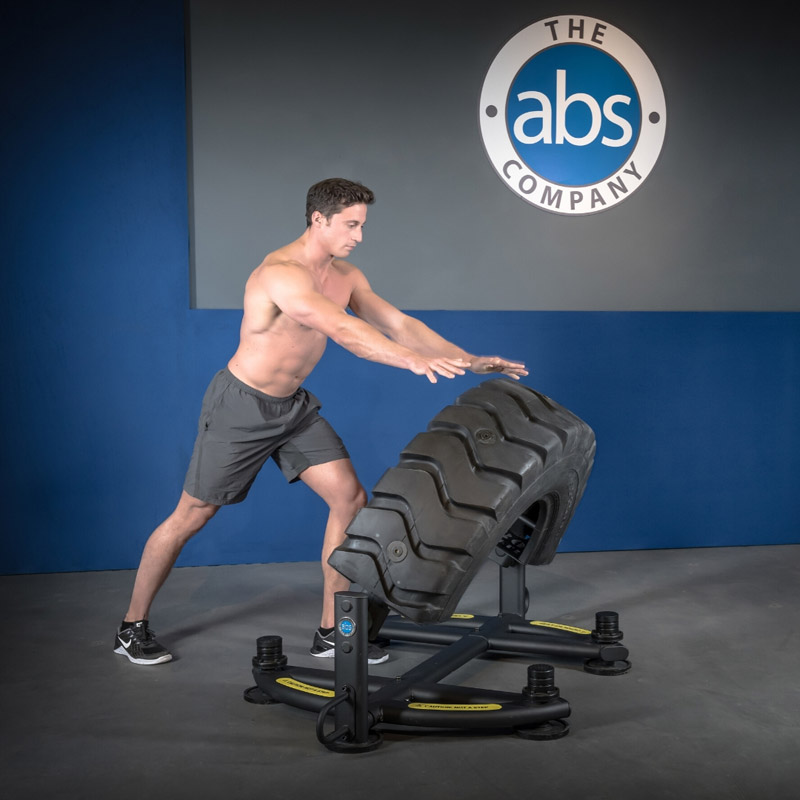
The tire squat and press is a dynamic exercise that targets multiple muscle groups simultaneously.
Muscles worked: quads, hamstrings, glutes, triceps, shoulders, chest, abs
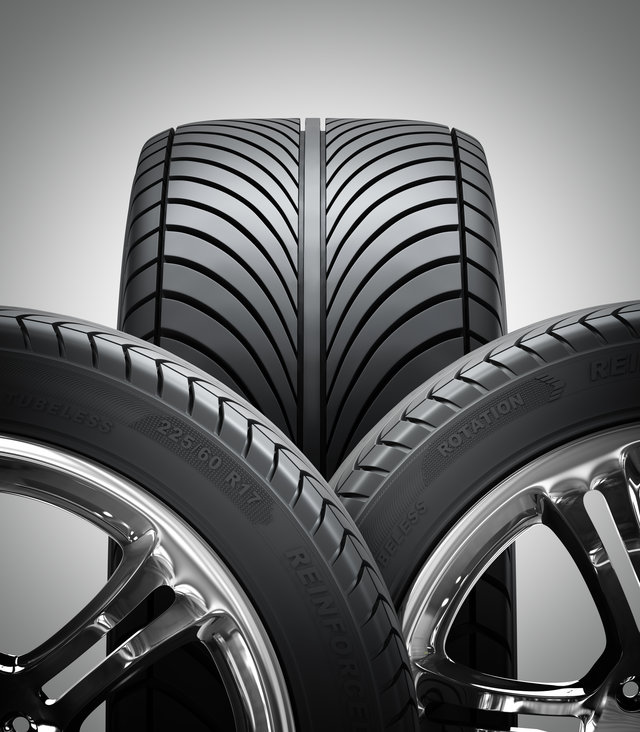
This high intensity tire movement will be sure to get your heart pumping.
Side-to-side hops provide excellent conditioning while hitting several major muscle groups.
Muscles worked: quads, hamstrings, glutes, shoulders, chest, triceps, abs
A tire circuit strategically combines a series of tire exercises to provide a high intensity, full-body workout.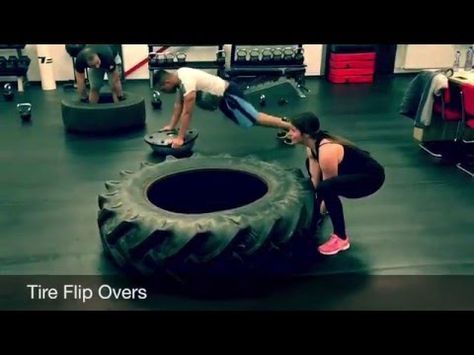
The goal during a tire circuit is to keep your heart rate elevated by performing movements back to back with only brief periods of rest in between.
Tire circuits can be performed as a training session on their own or added to a strength training program as additional conditioning work.
Here’s a sample tire circuit to get you started, incorporating the above movements.
Start with a 5–10-minute warmup to get your blood flowing and joints loosened up. Some suggested warmup methods include jumping rope or hitting the treadmill, elliptical, or spinning bike.
Follow this with some dynamic stretches to prime your joints for the high intensity movements to come.
This tire circuit is not for beginners. You’ll want to make sure you can perform each of the movements individually before attempting the circuit.
If you’re using a heavy tire, start with a total of 10 reps maximum of each exercise.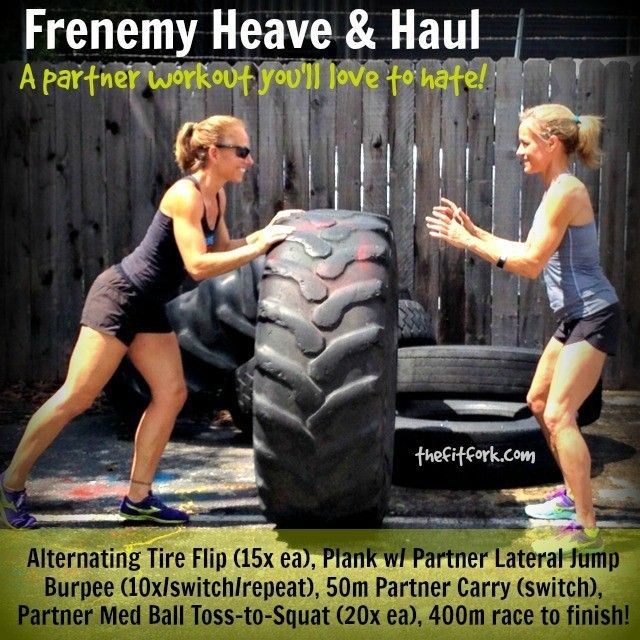 That can be accomplished with 2 sets of 5, or 3 sets of 3. If you’re using a lighter tire, you can do 3–4 sets with 6–10 reps each.
That can be accomplished with 2 sets of 5, or 3 sets of 3. If you’re using a lighter tire, you can do 3–4 sets with 6–10 reps each.
Feel free to swap out a movement if you’re unable to perform it. Always begin your workouts with more complex, compound exercises.
The main eventAfter an intense workout like a tire circuit, static stretching can help your muscles recover more quickly, reduce muscle soreness, and improve flexibility (3, 4).
Perform some general stretches to boost the recovery process and cool down after your workout.
SummaryThis intense tire circuit will put together all of the exercises previously introduced to give you a full-body workout that promotes both strength and conditioning.
Tire exercises are unique in that they provide a muscle stimulus unlike most other movements.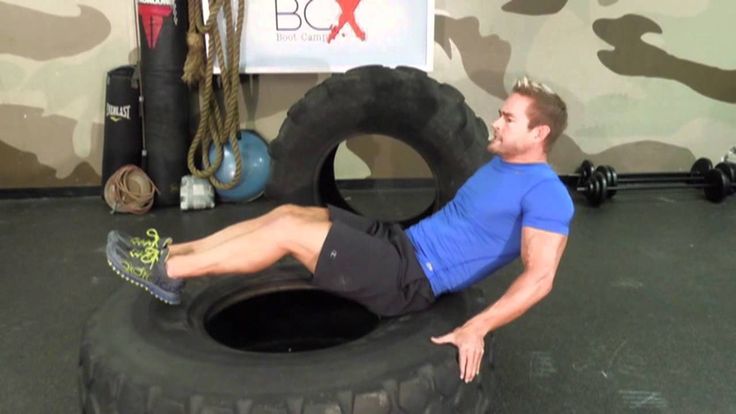
Completing tire exercises regularly comes with several potential benefits.
Multiple planes of movementThere are three planes of movement you move in during daily activities and exercise. These include frontal (side to side), sagittal (front to back), and transverse (rotational movement).
Many traditional exercises only work in one plane of movement, whereas most tire exercises utilize multiple planes of movement simultaneously.
This makes tire exercises transfer more efficiently to various sports, which also require you to move in multiple planes of motion.
Therefore, athletes training for their given sport may benefit from incorporating tire exercises into their exercise regimen.
Another notable benefit of tire exercises is their ability to provide both strength and conditioning training simultaneously.
Strength training, also known as resistance training, refers to moving your muscles against an external resistance as a means to increase muscle mass, metabolic rate, and bone mass, as well as prevent injuries (5).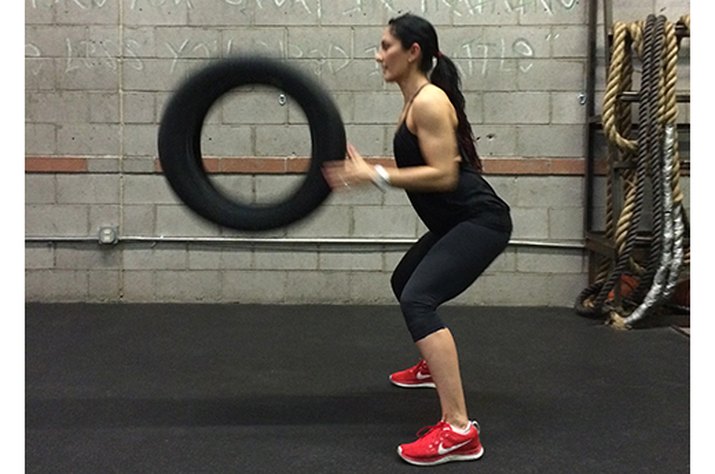
Conditioning, on the other hand, refers to performing high intensity movements specific to your sport that improve aerobic endurance, speed, skill, agility, and balance.
Most tire exercises tick both boxes, providing enough resistance to improve strength, while also providing high intensity movements that enhance conditioning applicable to a wide variety of sports.
That said, other methods of weight training should also be incorporated into your training program to maximize muscle and strength gains (6).
Power, or the ability to rapidly create maximal force, is an important aspect of athletic training.
Research suggests that power development is best trained with explosive movements at 30–50% of your one-repetition maximum (1RM), or the amount of weight you can lift for one rep of a given movement (7).
Many tire exercises fit this category, making them excellent for training power development.
To further enhance the power-developing effects of tire training, perform the movements explosively, providing maximal effort with each rep.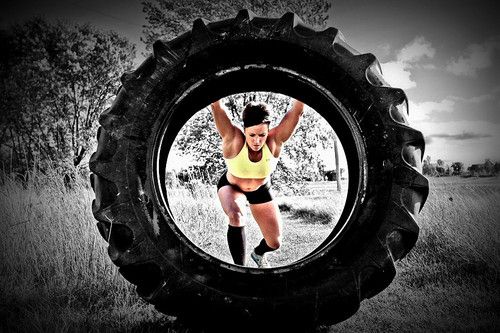
SummaryTire exercises provide a unique muscle stimulus that offers several benefits. These include providing movement through multiple planes, contributing to both strength and conditioning, and boosting power development.
While tires are an excellent tool to boost your exercise intensity, there are some precautions you should take to avoid getting injured.
Tires can be awkward to work with, especially the larger ones, and tire workouts require a great deal of skill to perform properly. As such, it’s important to focus on good technique throughout the movements.
One of the most common tire–related injuries is a bicep tear (8).
These often occur during the lifting portion of the tire flip, during which the biceps are in a stretched and compromised position.
To avoid a bicep tear during the tire flip, make sure to press your shoulder into the tire at the bottom of the movement and use the stronger muscles of your posterior (glutes, hamstrings, back muscles) for momentum. Avoid lifting the tire solely with your arms.
Avoid lifting the tire solely with your arms.
Other common injury–prone areas include the lower or mid-back, shoulders, and knees (8).
The best way to avoid injuries from tire exercises is to choose the right size tire for your level of strength and experience.
Work with a partner when possible to help you manipulate the tire and prevent it from falling on you.
SummaryGiven the size and weight of large tires, there’s a risk of injury when completing tire exercises. Select the right size tire for your level of strength, and work with a partner when possible to best avoid injuries.
Tire exercises have emerged as a training strategy for athletes and recreational gym-goers alike.
They can be strategically combined to create a tire circuit that provides a well-balanced, full-body workout, hitting all of your major muscle groups.
Regularly performing tire training comes with several potential benefits, including providing movement through multiple planes, contributing to both strength and conditioning, and boosting power development.
Considering the large size and weight of many tires, they present a significant risk for various injuries. Therefore, it’s best to start with a lighter tire and gradually progress as you become stronger.
Whether you’re an athlete looking to improve your performance or a recreational gym-goer looking to improve your fitness, tire exercises may be an excellent addition to your training program.
Gone are the days when training was limited to the same old traditional gym.
Although originally used in strongman and strongman competitions, tires have become a staple in well-equipped gyms around the world.
They provide unique strength and conditioning training that can be easily transferred to different sports.
This article introduces the best splint exercises, the muscles they work, and an example splint circuit to get you started.
The key to doing splint exercises is to select the correct size and weight of splints for your level of strength and experience, and to avoid injury.
Start with a smaller, lighter tire and progress to a larger, heavier tire as you develop strength and skill. Women are recommended to start with a 100–200 lb (45–90 kg) tire, while men are recommended to start with a 200–300 lb (90–135 kg) tire.
As a rule of thumb, you should do 2-5 repetitions of the exercises below in sequence. If you can't, the tire is probably too heavy.
Tire weight estimation is not an exact science. However, there are some average values depending on the size (1, 2).
| Tire size | Average tire weight |
| Vehicle tire | 25 lb (11 kg) |
| Commercial cargo tire | 100-200 pounds (about 45–91 kg) |
| Tire tire 17.5 x 25 feet | 300 pounds (136 kg), maximum |
| Tractor Shina 20 FUT | 400 500–181 227 pounds (xnumx xnumx - xnumx xnumx kg) |
Tire tire 23. 5 x 25 feet 5 x 25 feet | 400-800 pounds (181–363 kg) |
It can be hard to know how much a tire weighs because it's hard to put a large tractor tile on the scale. If you are transporting it by truck, you can drive up to the CAT scale, measure the weight of your truck with the tire, and then subtract the weight of your truck to find the weight of the tire.
Some specialty tires allow you to add or remove weights, making it a little easier to add resistance.
Conclusion
Tires can be difficult to weigh and are often estimated. Choose a tire size that allows you to consistently perform at least 2-5 reps.
Tire availability depends on where you live.
Those who live in rural areas may find it easier to find old tires from agricultural equipment, which is also the most cost-effective source.
You can check your local classifieds online for listings of people selling used tires, as larger new tires tend to be quite expensive.
While car tires may be suitable for some exercises, you will need a slightly larger tire to perform most movements better, especially as your strength and skill increase.
Fortunately, many gyms now have indoor or outdoor areas with turf and tire access.
Conclusion
Tires are best found by searching local listings online or by contacting a farm that has agricultural equipment. In addition, many gyms now have a turf area with different tire sizes for members to use.
Splint Flip is a classic splint exercise that develops explosive strength from head to toe.
The key to this exercise is choosing the correct tire size and weight for your level of strength and experience, and avoiding injury.
Muscles worked: glutes, hamstrings, quads, calves, lats, traps, biceps, triceps, forearms, abs (for stabilization)
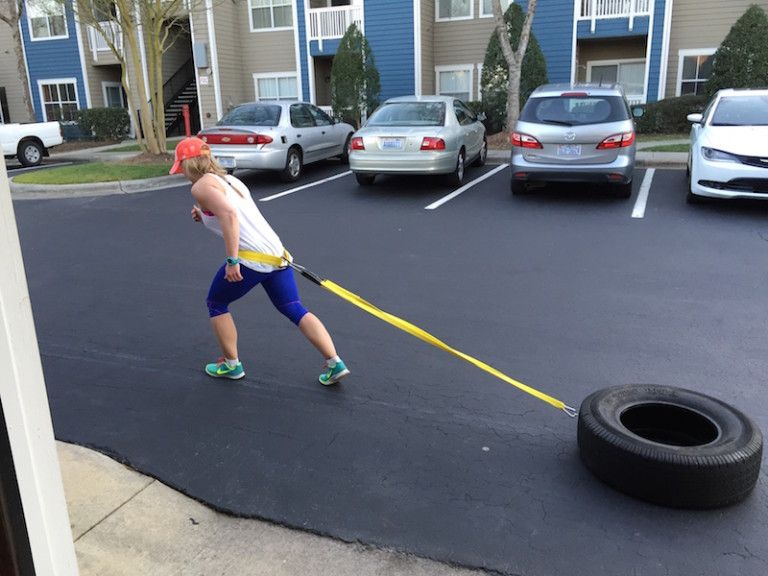
Farm Walk Tire Deadlift is a unique tire exercise that provides all the benefits of a traditional deadlift with the added aspect of conditioning.
This movement requires excellent body strength and traction to stabilize the tire while the farmer is walking.
Muscles worked: glutes, hamstrings, quads, lats, traps, biceps, forearms, abs
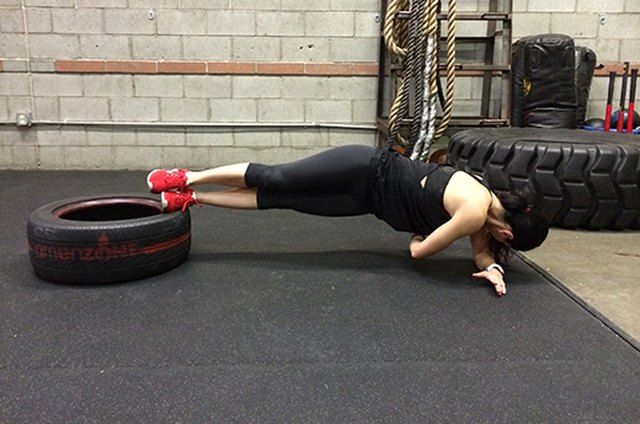
This move can also be done without the farmer's step as a deadlift for only a certain number of sets and reps.
Tire hit is an excellent exercise for developing upper body strength and endurance in various planes of motion.
This exercise requires a sledgehammer or mace as a practice tool for hitting the splint.
You must use a tire that is large enough to absorb the shock of the impact without moving too much.
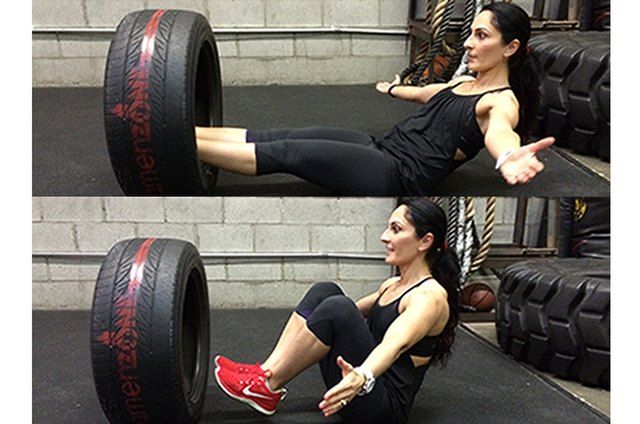
Tire hitting can be done in timed intervals where you hit the tire for a set amount of time, or in sets where you hit the tire for a set number of repetitions or hits.
This is a dynamic exercise that combines two popular splint exercises to maximize your training adaptation.
For this exercise, it is best to choose a lighter tire that you can comfortably jump over several times.
Muscles worked: quads, hamstrings, glutes, calves, lats, traps, biceps, forearms, abs

Box jumps are a common plyometric exercise in which your muscles exert maximum force over a short period of time.
This variant uses a tire instead of a box, which creates an additional level of difficulty as you will need to stabilize yourself on landing due to the flex in the tire.
Choose the right tire height for your skill level.
Two tires can be stacked on top of each other as you get more advanced.
Muscles worked: quads, hamstrings, glutes, calves, abs

Tire Dips are a versatile upper body exercise that can be customized to your desired level of difficulty.
Beginners should do elevated torso pushups to reduce resistance, while more advanced trainees may try leg elevated pushups to increase resistance.
Muscles worked: pecs, anterior delts, triceps, abs

The plank is a challenging exercise that engages the abdominal muscles.
In this variation, you will use the tire to increase or decrease the level of difficulty.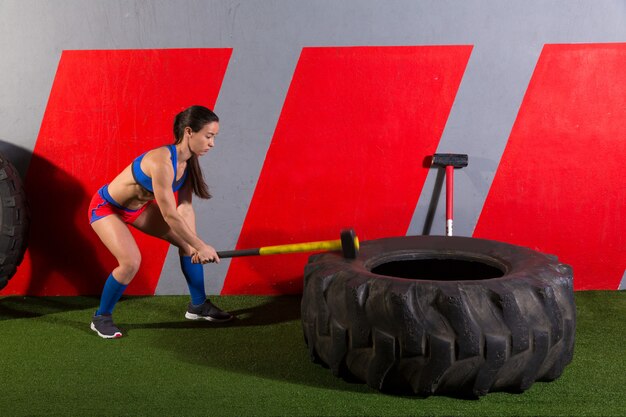
To make the exercise a little easier, you will do the plank on an incline bench, or if you want to do something better, you can do the plank on an incline bench.
Muscles worked: abs, obliques (side press), lower back
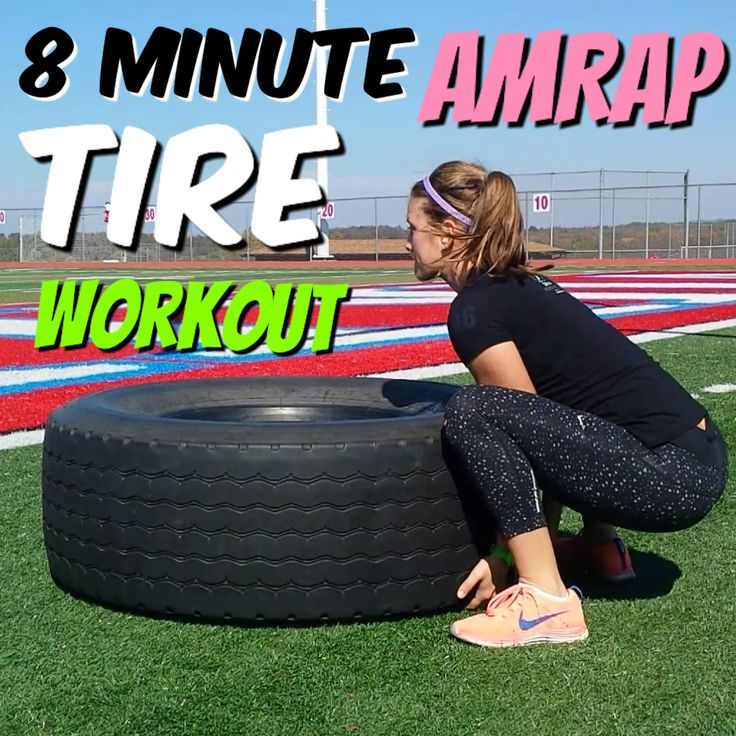
For this movement you will need a tire large enough to support your body weight without tipping over.
Muscles worked: triceps, chest, shoulders
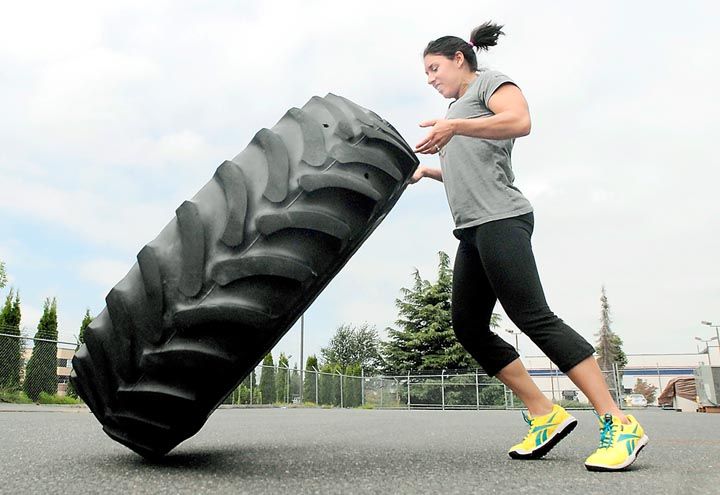
The Tire Squat & Press is a dynamic exercise that works multiple muscle groups simultaneously.
Muscles worked: quads, hamstrings, glutes, triceps, shoulders, chest, abs
This high intensity tire movement is sure to get your heart racing.
Side-to-side jumping provides excellent physical fitness while simultaneously engaging several major muscle groups.
Muscles worked: quads, hamstrings, glutes, shoulders, chest, triceps, abs
The splint circuit strategically combines a series of splint exercises to provide a high intensity full body workout.
The purpose of the lap with splints is to maintain an elevated heart rate by performing back-to-back movements with short rest periods in between.
Tire laps can be done as a standalone workout or added to a strength training program as an additional conditioning job.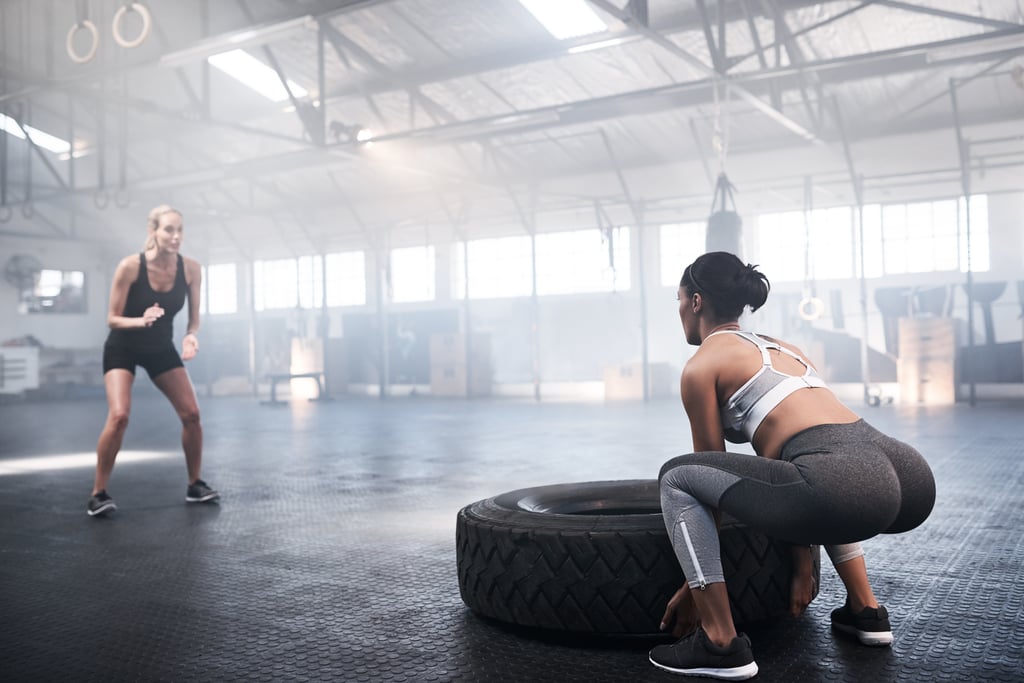
Here is an example of a tire pattern to start with, including the above movements.
Start with a 5-10 minute warm-up to get your blood flowing and relax your joints. Some suggested warm-up methods include jumping rope or exercising on a treadmill, elliptical trainer, or exercise bike.
Then do some dynamic stretches to prepare your joints for the high intensity movement ahead.
This track with tires is not for beginners. You must ensure that you can perform each of the movements individually before attempting the pattern.
If you are using a heavy splint, start with a maximum of 10 reps per exercise. This can be achieved with 2 sets of 5 reps or 3 sets of 3 reps. If you are using a lighter splint, you can do 3-4 sets of 6-10 reps each.
Feel free to change a move if you can't do it. Always start training with more complex complex exercises.
Do some general stretching to speed up the recovery process and cool down after your workout.
Conclusion
This intense splint circuit will combine all of the exercises presented earlier to give you a full body workout that promotes both strength and fitness.
Splint exercises are unique in that they provide muscle stimulation unlike most other movements.
Regular exercise with splints has several potential benefits.
There are three movement plans in which you move during daily activities and exercises. These include frontal (side to side), sagittal (front to back), and transverse (rotational movements).
Many traditional exercises only work on one plane of motion, while most splint exercises use multiple planes of motion at the same time.
This makes splint exercises more effective for a variety of sports that also require you to move in multiple planes.
Thus, athletes in their sport may benefit from incorporating splint exercises into their training regimen.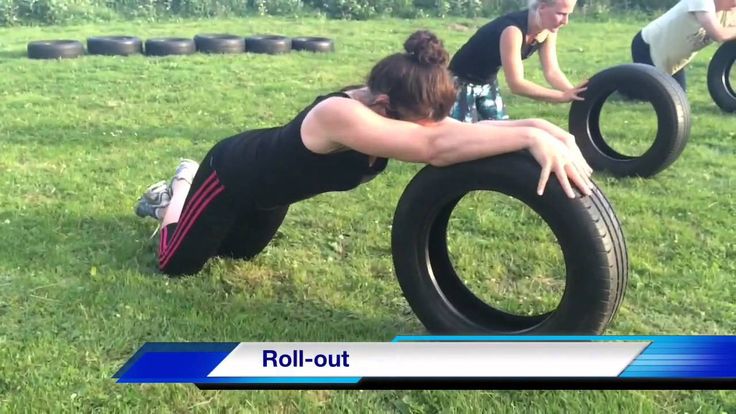
Another notable benefit of splint exercise is its ability to provide strength and conditioning at the same time.
Strength training, also known as resistance training, refers to the movement of muscles against external resistance as a means of increasing muscle mass, metabolic rate and bone mass, and to prevent injury.5).
Conditioning, on the other hand, refers to performing high-intensity movements specific to your sport that improve aerobic endurance, speed, skill, agility, and balance.
Most splint exercises fit both, providing enough resistance to increase strength as well as providing high-intensity movements that improve fitness across a wide range of sports.
However, other strength training methods should also be included in your training program to maximize muscle and strength gains (6).
Power, or the ability to quickly develop maximum strength, is an important aspect of athletic training.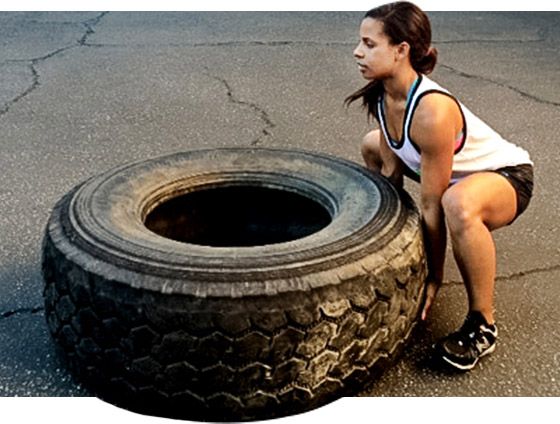
Research shows that strength development is best trained with explosive movements of 30–50% of your 1RM or the weight you can lift in one rep of the movement (7).
Many splint exercises fit into this category, making them excellent for strength development.
To further enhance the effect of training with splints for strength development, perform movements in an explosive manner, applying maximum effort in each repetition.
Conclusion
Splint exercises provide a unique muscle stimulus that provides several benefits. These include providing movement in multiple planes, contributing to both strength and conditioning, as well as accelerating power development.
While splints are a great tool to increase the intensity of your workout, there are some precautions you should take to avoid injury.
Splints can be awkward to work with, especially large ones, and training with splints requires a lot of skill to perform correctly. Thus, it is important to focus on good technique in all movements.
Thus, it is important to focus on good technique in all movements.
One of the most common splint-related injuries is a ruptured bicep (8).
This often occurs during the lifting part of a tire rollover, during which the bicep is in a stretched and compromised position.
To avoid tearing your biceps during a splint roll, be sure to keep your shoulder against the splint at the bottom of the movement and use stronger hamstring muscles (glutes, hamstrings, back muscles) to generate momentum. Do not lift the tire with your hands only.
Other common injury-prone areas include the lower or middle back, shoulders, and knees.8).
The best way to avoid injury when exercising with splints is to choose the right size splint for your strength level and experience.
If possible, work with a partner to help you manipulate the tire and prevent it from falling on you.
Conclusion
Given the size and weight of the large splints, there is a risk of injury when exercising with splints.
Choose a tire size that matches your strength level and work with a partner whenever possible to avoid injury.
Tire exercise has become a training strategy for athletes and gym goers alike.
They can be strategically combined to create a splint pattern that provides a well-balanced full-body workout targeting all major muscle groups.
Regular tire training has several potential benefits, including providing multi-plane movement, promoting both strength and fitness, and accelerating power development.
Given the large size and weight of many tires, they pose a significant risk of injury. So it's best to start with a lighter tire and gradually progress as you get stronger.
Whether you're an athlete looking to improve your performance or a gym enthusiast looking to improve your fitness, splint exercises can be a great addition to your workout program.
This weird but fun exercise can improve both your upper and lower body strength and increase your endurance.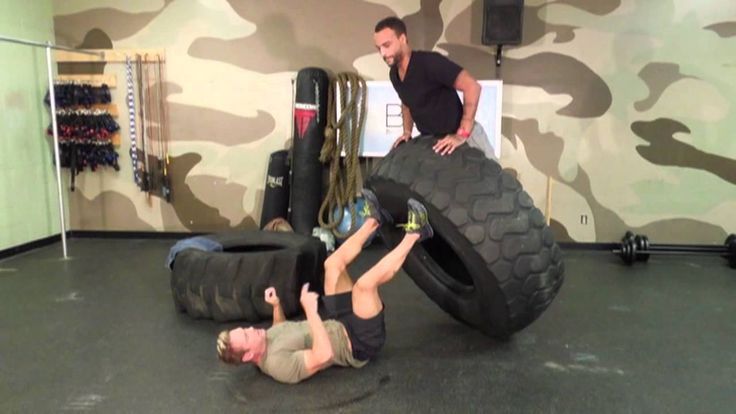
Tags:
Question answer
Power training
Trainer's Tips
pressfoto / Freepik
Many people are looking for fun and creative ways to get in shape and add variety to their exercises. But it is important to understand that it is the strength training routine performed year after year that will give you exactly what you need. But if you want to improve your strength and fitness while doing something new, get a big tire.
Splint workouts add a variety of elements that other exercises can't provide. And although this projectile is familiar to us, first of all, thanks to strongman competitions, every athlete can benefit from working with him.
Strongman competition has become more popular in recent years, and since then the training methods used by these strongmen have been introduced into the daily workouts of gym goers.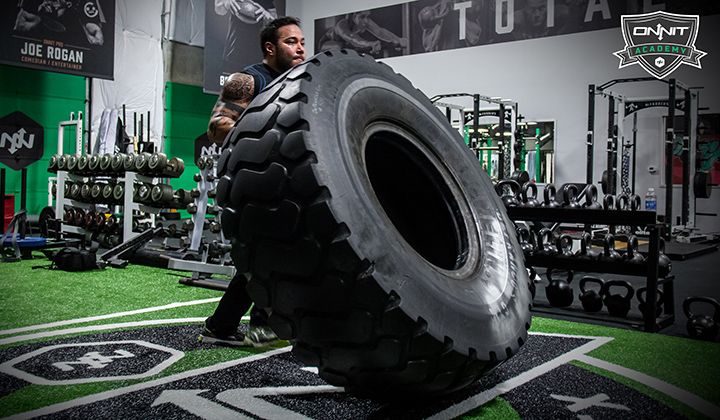 Since only a tire is required to flip, it has become an inexpensive and effective way to really increase the effectiveness of training by introducing new elements into it and taking performance to a new level.
Since only a tire is required to flip, it has become an inexpensive and effective way to really increase the effectiveness of training by introducing new elements into it and taking performance to a new level.
Tire Flip consists of several movements: crouching, lifting and then pushing. As a result, for each of these movements, you engage different muscle groups in the upper and lower body. This exercise targets the posterior chain, which includes the back, glute, and hamstrings, to increase lower body strength.
ADVERTISING - CONTINUED BELOW
As a challenging exercise, it uses the stabilizing muscles of the entire body. Maintaining good posture forces the upper body to work at the same intensity, and while the lift is important, it should be noted that one should not lift straight up.
Keeping your core tight will give you a good ab workout. As with many other exercises, the core serves as a base for support, keeping the body in tension to avoid extra movements that can lead to injury.
As with many other exercises, the core serves as a base for support, keeping the body in tension to avoid extra movements that can lead to injury.
However, being a physically demanding exercise, flipping the tire will improve your heart rate and build endurance. This exercise has been used in various obstacle races and competitions to test strength and endurance abilities. Your power output will increase because it is an explosive movement. It's great for boosting fast athletic performance, once you get the hang of it, you'll immediately understand why strongmen love flipping tires so much.
After a good warm-up, you can start the exercise with a tire flip. Place the desired size tire on the ground, making sure there is enough room to turn it over and continue the exercise. Sit next to her, bending your knees and lowering your pelvis down and back. With a tight core and a neutral spine, grasp the splint and lift your hips up as you lift the splint.